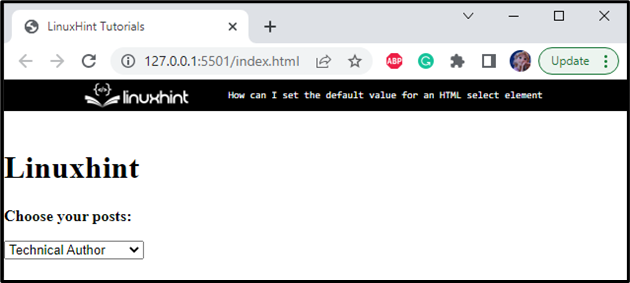In web development, while making a form, we need different components, such as input fields, buttons, radio buttons, checklists, and many more. The drop-down menu is one such component that is added in a form to select an option from a list of menus. This can be made on a web page using an HTML <select> element consisting of several options specified within the HTML <option> element.
This study will demonstrate the method to set a default value for an HTML <select> element.
How to Specify Default Value for HTML <select> Element?
Sometimes, the “selected” attribute must be added for setting a default option. Within the drop-down list, the option with the selected attribute will be shown by default.
The syntax below displays how to make an option a default value:
Check out the example below for the demonstration!
Example: Setting Default Value for HTML <select> Element
In HTML, first, add a div element with the class name “content”. Inside this element:
- Add a heading element <h1>.
- Then, add the <p> element with some content. The <strong> element within the <p> element is utilized to make the text bold.
- Include the HTML “<select>” element with the attributes name and id.
- As we have discussed above, the select element contains the available options within the drop-down menu. These options are specified with the HTML “<option>” element.
So, look at the below-given code snippet where the second option is specified with the attribute “selected” to define it as the default value:
<h1>Linuxhint</h1>
<p><strong>Choose your posts:</strong></p>
<select name="profession" id="profession">
<option value="software developer">Software Developer</option>
<option value="technical author" selected>Technical Author</option>
<option value="data scientist">Data Scientist</option>
<option value="financial manager">Financial Manager</option>
</select>
</div>
In this case, “Technical Author” will be selected and displayed as the default option:
Let’s head over to the CSS section, where we will use different CSS styling properties to style the HTML elements.
Style “content” div
width: 370px;
height: 280px;
border: 1px solid #874C62;
margin: auto;
background-color: rgb(34, 32, 32);
padding: 18px;
border-radius: 6px;
}
The “.content” is utilized to access the HTML div element with the class content. The explanation of the above-mentioned CSS properties is listed below:
- “width” property adjusts the element’s width.
- “height” property determines the element’s height.
- “border” property specifies the border around the element. The value specifies the border width, border style, and border color.
- “margin” property specifies the amount of space around the element.
- “background-color” specifies the element’s background color.
- “padding” is utilized to increase space around the element’s content.
- “border-radius” is the property that makes the element’s corners round.
Style “p” Element
font-size: 20px;
color: #fff;
}
The <p> element of the div content is styled with the following properties:
- “font-size” sets the element’s font size.
- “color” property adjusts the element’s font color.
Style “select” Element
padding: 5px;
border-radius: 5px;
outline: none;
font-size: 18px;
}
The select element is applied with the following properties:
- “outline” property specifies a border or outline around the element, mainly when it is selected.
- The “padding”, “border-radius”, and “font-size” properties perform functions as stated above.
Style “h1” Element
text-align: center;
font-size: 45px;
color: #e485b9;
}
The <h1> element is decorated with the following properties:
- “text-align” property adjusts the element’s text alignment.
- “font-size” and “color” properties styled the element in a way as stated above.
The below GIF displays the final result of the code:
This is how you can set the default value for an HTML <select> element.
Conclusion
The HTML <select> element comprises several menus that are selectable. These menus are specified within the HTML <option> element. To set the default value for an HTML <select> element, it is required to specify the attribute “selected” for that option. This study has described the HTML <select> element and the method to set its default value with a practical example.


